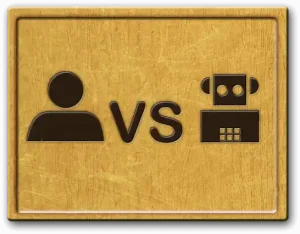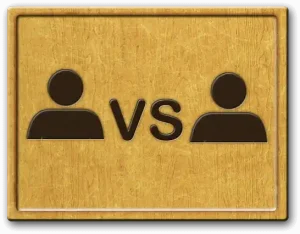Chess against the computer

Play chess against the computer. Instant game available. 100% free!
Ben Franklin here aka The Chess Maestro. Great to see you.
I know, you’re thinking, how can such a handsome bear be so good at Chess. The answer is simple…. Practice.
….and you have come to the right place to load up on practice.
Hit the play button.
Play chess against the computer
Press the ![]() button to CONTRACT and EXPAND the screen area
button to CONTRACT and EXPAND the screen area
Press the  play button
play button
The computer has three skill levels. The skill levels are not set too high but you will still have to play skillfully in order to win.
![]() Easy (OFF)
Easy (OFF)
![]() Medium (OFF)
Medium (OFF)
![]() Hard (SELECTED)
Hard (SELECTED)
 Play the computer?
Play the computer?
Or
 Play someone else on this board.
Play someone else on this board.
Chess is great mental exercise. PLAY IT NOW (Work can wait!!)
History of Chess
History of Chess: From Ancient Beginnings to The Present Day
Chess, often regarded as the “Game of Kings”. It has a rich and storied history that spans over a millennium. Its origins are shrouded in mystery, but through historical records, we can piece together the captivating journey of how chess evolved from its early forms into the sophisticated game we play today.
Origins in India (6th Century AD)
The roots of chess can be traced back to ancient India, where it was known as “chaturanga,” a term that means “four divisions of the military” – infantry, cavalry, elephants, and chariotry. Chaturanga was created as a war simulation game, a representation of the strategic maneuvers on the battlefield. In this early version, the pieces represented the different arms of the Indian army:
- The King (Raja) was the central piece, representing the monarch and was relatively weak in terms of movement.
- The Elephant (Gaja) became the modern Bishop and moved diagonally.
- The Horse (Ashva) eventually transformed into the Knight, moving in its distinctive L-shape.
- The Chariot (Ratha) later became the Rook and moved horizontally or vertically.
- The Infantry (Padàtis) or Foot Soldier evolved into the modern Pawn, moving forward one square.
Spread to Persia and the Islamic World (6th to 7th Century AD)
Chess gradually spread to Persia, where it was known as “shatranj.” The game’s rules began to evolve during this time, with the most significant change being the enhancement of the Queen (Ferz) to a more powerful piece, capable of moving diagonally any number of squares.
In the Islamic world, chess found a welcoming and vibrant community of players and scholars who made substantial contributions to the game’s development. They not only translated Indian and Persian texts on chess but also wrote their own treatises and commentaries. By the 9th century, chess was an integral part of Islamic culture.
Introduction to Europe (9th to 10th Century AD)
Chess made its way to Europe through the Moors’ conquest of Spain in the 8th century. Initially viewed with suspicion by the Catholic Church, chess eventually gained acceptance and popularity among European nobility during the Middle Ages. As it spread across the continent, it underwent several transformations:
- Queen’s New Power: The Queen’s power evolved further, allowing it to move both horizontally and vertically across the board.
- Castling: The concept of castling, a move that allows the King to escape danger while developing a Rook, was introduced.
The Renaissance and Birth of Modern Chess (15th Century AD)
The late Middle Ages and the Renaissance saw a series of important changes in chess rules and gameplay. The rules of pawn promotion and en passant capture were standardized. Castling rules were also refined to resemble the modern version more closely.
One of the most notable figures in this period was Ruy López de Segura, a Spanish priest who wrote one of the earliest known chess manuals, “Libro de la invención liberal y arte del juego del ajedrez” (The Book of the Liberal Invention and Art of the Game of Chess), in 1561. His work helped codify many of the rules and strategies of chess.
The Birth of Competitive Chess (19th Century AD)
The 19th century marked a turning point for competitive chess. Tournaments became popular, and the first international chess tournament was held in London in 1851. This event brought together players from various countries and established a framework for international chess competition.
During this time, many great chess players emerged, including Wilhelm Steinitz, the first recognized World Chess Champion, who introduced the concept of positional chess and the endgame theory.
The Modern Era (20th Century to Present)
The 20th century saw the continued growth of chess as a global sport. The World Chess Championship became a prestigious title, with players like Emanuel Lasker, José Capablanca, Alexander Alekhine, and Mikhail Botvinnik holding the crown.
The introduction of chess engines and computer analysis revolutionized the way the game is played and studied. In 1997, IBM’s Deep Blue famously defeated World Chess Champion Garry Kasparov, showcasing the increasing power of artificial intelligence in chess.
Today, chess enjoys a massive following, both as a professional sport and a recreational activity. Online platforms have made it accessible to people all over the world, enabling players of all skill levels to compete and learn from one another.
Conclusion
From its humble beginnings in ancient India as a representation of warfare, chess has evolved into a complex, strategic game that continues to captivate minds worldwide. Its journey through India, Persia, the Islamic world, and Europe reflects not only the game’s adaptability but also its enduring appeal as a test of intellect and strategy. As chess continues to evolve in the digital age, its history remains an essential part of its enduring allure.
In the grand tapestry of human culture, chess stands as a testament to the power of innovation and human ingenuity, reminding us that even the simplest of games can become a canvas for intellectual achievement and endless fascination. Whether you’re a grandmaster or a novice, the history of chess adds depth and context to every move on the board, making each game a journey through time and tradition.
